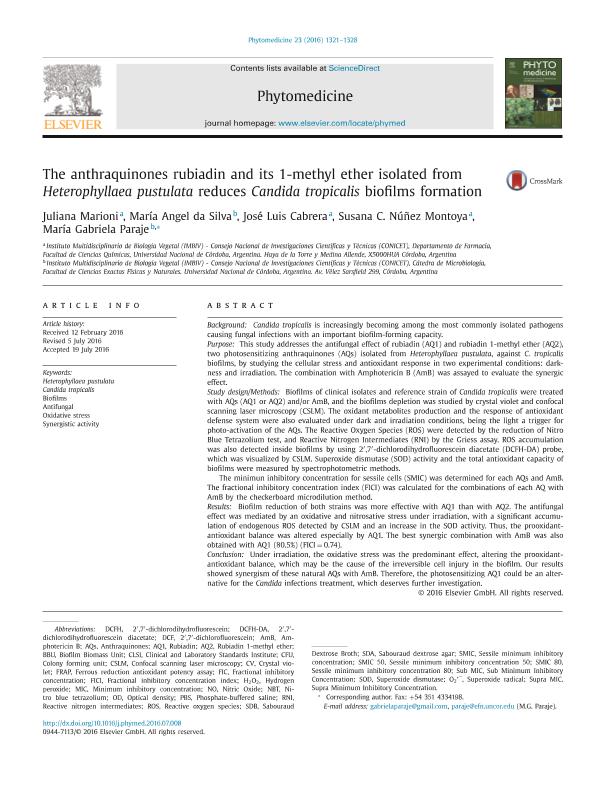Artículo
The anthraquinones rubiadin and its 1-methyl ether isolated from Heterophyllaea pustulata reduces Candida tropicalis bioÞlms formation
Marioni, Juliana ; Da Silva, María Angel
; Da Silva, María Angel ; Cabrera, Jose Luis
; Cabrera, Jose Luis ; Núñez Montoya, Susana Carolina
; Núñez Montoya, Susana Carolina ; Paraje, María Gabriela
; Paraje, María Gabriela
 ; Da Silva, María Angel
; Da Silva, María Angel ; Cabrera, Jose Luis
; Cabrera, Jose Luis ; Núñez Montoya, Susana Carolina
; Núñez Montoya, Susana Carolina ; Paraje, María Gabriela
; Paraje, María Gabriela
Fecha de publicación:
11/2016
Editorial:
Elsevier Gmbh
Revista:
Phytomedicine
ISSN:
0944-7113
Idioma:
Inglés
Tipo de recurso:
Artículo publicado
Clasificación temática:
Resumen
Background: Candida tropicalis is increasingly becoming among the most commonly isolated pathogens causing fungal infections with an important biofilm-forming capacity.Purpose: This study addresses the antifungal effect of rubiadin (AQ1) and rubiadin 1-methyl ether (AQ2), two photosensitizing anthraquinones (AQs) isolated from Heterophyllaea pustulata, against C. tropicalis biofilms, by studying the cellular stress and antioxidant response in two experimental conditions: darkness and irradiation. The combination with Amphotericin B (AmB) was assayed to evaluate the synergic effect.Study Design/Methods: Biofilms of clinical isolates and reference strain of Candida tropicalis were treated with AQs (AQ1 or AQ2) and/or AmB, and the biofilms depletion was studied by crystal violet and confocal scanning laser microscopy (CSLM). The oxidant metabolites production and the response of antioxidant defense system were also evaluated under dark and irradiation conditions, being the light a trigger for photo-activation of the AQs. The Reactive Oxygen Species (ROS) were detected by the reduction of Nitro Blue Tetrazolium test, and Reactive Nitrogen Intermediates (RNI) by the Griess assay. ROS accumulation was also detected inside biofilms by using 2′,7′-Dichlorodihydrofluorescein diacetate (DCFH-DA) probe, which was visualized by CSLM. Superoxide dismutase (SOD) activity and the total antioxidant capacity of biofilms were measured by spectrophotometric methods. The minimun inhibitory concentration for sessile cells (SMIC) was determined for each AQs and AmB. The fractional inhibitory concentration index (FICI) was calculated for thecombinations of each AQ with AmB by the checkerboard microdilution method.Results: Biofilm reduction of both strains was more effective with AQ1 than with AQ2. The antifungal effect was mediated by an oxidative and nitrosative stress under irradiation, with a significant accumulation of endogenous ROS detected by CSLM and an increase in the SOD activity. Thus, the prooxidant-antioxidant balance was altered especially by AQ1. The best synergic combination with AmB was also obtained with AQ1 (80.5 %) (FICI = 0.74).Conclusion: Under irradiation, the oxidative stress was the predominant effect, altering the prooxidant-antioxidant balance, which may be the cause of the irreversible cell injury in the biofilm. Our results showed synergism of these natural AQs with AmB. Therefore, the photosensitizing AQ1 could be an alternative for the Candida infections treatment, which deserves further investigation.
Archivos asociados
Licencia
Identificadores
Colecciones
Articulos(IMBIV)
Articulos de INST.MULTIDISCIPL.DE BIOLOGIA VEGETAL (P)
Articulos de INST.MULTIDISCIPL.DE BIOLOGIA VEGETAL (P)
Citación
Marioni, Juliana; Da Silva, María Angel; Cabrera, Jose Luis; Núñez Montoya, Susana Carolina; Paraje, María Gabriela; The anthraquinones rubiadin and its 1-methyl ether isolated from Heterophyllaea pustulata reduces Candida tropicalis bioÞlms formation; Elsevier Gmbh; Phytomedicine; 23; 12; 11-2016; 1321-1328
Compartir
Altmétricas



